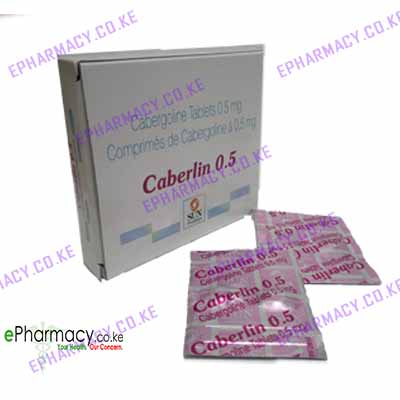Description
Cabergoline, an ergot derivative, is a dopamine D2-agonist with actions and uses similar to those of bromocriptine. It is a potent and long-lasting inhibitor of prolactin secretion used in the management of disorders associated with hyperprolactinaemia. It is also used to suppress puerperal lactation for medical reasons; it is not recommended for the routine suppression of physiological lactation or for the treatment of postpartum breast pain and engorgement that may be adequately relieved with simple analgesics and breast support. Cabergoline is also used in the management of Parkinson’s disease.
Cabergoline is administered by mouth and should be taken with food.
To inhibit physiological lactation, cabergoline is given as a single 1-mg dose on the first day postpartum. For suppression of established lactation, the dose is 250 micrograms every 12 hours for 2 days.
In the treatment of disorders associated with hyperprolactinaemia, the initial dose of cabergoline is 500 micrograms weekly. The dose is then increased at monthly intervals in increments of 500 micrograms weekly according to response. The weekly dose may be administered on a single occasion or divided into 2 doses on separate days; doses over 1 mg should be given as divided doses. The usual dose is 1 mg weekly but up to 4.5 mg has been used.
In Parkinson’s disease, cabergoline is used as an adjunct in patients experiencing ‘on-off’ fluctuations in control with levodopa treatment. It should be introduced gradually and during this period the dose of levodopa may be reduced gradually until an optimal response is achieved. A suggested initial dose of cabergoline is 1¬†mg as a single daily dose. The dose may be increased in increments of 0.5 or 1¬†mg at intervals of 7 or 14 days. The recommended therapeutic dose range is 2 to 6¬†mg daily.
Acromegaly.
Dopamine agonists have been used in acromegaly as adjuvants to surgery, radiotherapy, or somatostatin analogues to reduce circulating growth hormone concentrations, although they are less effective than the somatostatin analogue octreotide. However, a small study comparing cabergoline with depot bromocriptine and quinagolide failed to find evidence of its effectiveness.
Hyperprolactinaemia and prolactinomas.
Dopamine agonists are widely used for the treatment of hyperprolactinaemia secondary to a prolactinoma. Although bromocriptine has been the first choice for this indication, some now prefer cabergoline,1 which appears to be more effective and better tolerated.
Caberlin in Lactation inhibition
A single 1-mg dose of cabergoline was found to be as effective as bromocriptine 2.5 mg given twice daily for 14 days for preventing puerperal lactation in a double-blind multicentre study involving 272 women.1 It has been suggested that cabergoline would be a better choice than bromocriptine for lactation inhibition. the routine use of dopaminergics such as bromocriptine or cabergoline is not recommended for the suppression of physiological lactation.
Uses of Caberlin 0.5mg in Parasomnias
The aetiology of restless legs syndrome is obscure and treatment has been largely empirical but dopaminergic therapy has emerged as a common first-line choice. Long acting drugs such as cabergoline may be preferred in order to avoid the complications associated with levodopa therapy. Results from a 12-week open label pilot study1 in 9 patients with idiopathic restless legs syndrome given cabergoline following insufficient response to levodopa therapy were promising; doses of cabergoline ranged from 1 to 4 mg.
Parkinsonism.
Cabergoline is used as a long-acting dopamine agonist in Parkinson’s disease. Dopamine agonists are often used to begin treatment in an attempt to delay therapy with levodopa, particularly in younger patients. They also have an adjunctive use when levodopa is no longer effective alone or cannot be tolerated, and may sometimes be useful in reducing ‘off’ periods with levodopa and in ameliorating other fluctuations of mobility in the later stages of the disease.
Adverse Effects and Side Effects of Caberlin tablets in Kenya
- Nausea and Vomiting are common
- As a vasoconstrictor, high doses of Caberlin might lead to cold arms and leg cramps



Reviews
There are no reviews yet.